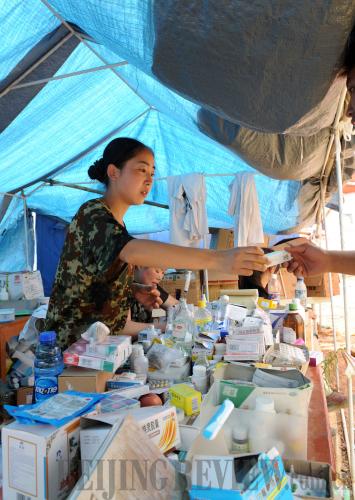|
 |
|
TIMELY AID: A disease control worker hands out disinfectants and most commonly used drugs to people who live in tents after a catastrophic earthquake in Wenchuan, Sichuan Province, on May 12, 2008 (ZHANG LING) |
A mature mechanism
After the SARS outbreak, the Ministry of Health set up a medical emergency response office in early 2004.
In August 2007, the Emergency Response Law was adopted by the NPC Standing Committee. According to the law, all ministries quickly formulated their emergency response plans, covering circumstances including severe epidemics, natural disasters, poisoning incidents, environmental pollution, nuclear leaks and major railway, civil aviation, power and coalmine accidents.
"The emergency response planning started in China in the field of disease control, which permeated the entire field of public health and eventually covered all kinds of safety hazards. This progress can be regarded as a legacy of the SARS outbreak," Zeng said.
Over the past decade, the Law on the Prevention and Treatment of Infectious Diseases, the Frontier Health and Quarantine Law and the Animal Epidemic Prevention Law were also amended to become more effective in containing the spread of infectious diseases after revision.
According to Wang Yu, over the past decade, China's disease control system has made great progress, where passive reaction to an ongoing pandemic has been replaced by response planning in advance and isolated reactions taken by local authorities replaced by systematic and joint efforts. He said that the whole country has already been covered by a network of controlling and treating infectious diseases.
Wang's daily work includes checking the daily update of infectious disease cases collected by local disease control and prevention agencies from across the country by logging into an internal database from his computer. Even cases of unknown diseases will be reported through this system.
"This system is useful for us to collect information timely and obtain the disease spectrums of specific regions and age groups in the long term, which can be used as reference for the government's decision making and planning of investment in local health services," Li said.
Li is the first person to suggest the establishment of such a unified national information system to the Central Government. When then Vice Premier Wu Yi visited the CDC on April 1, 2003 in the heat of the SARS outbreak, Li highlighted the need for a national information system, which would alert the center of a new SARS case in the country immediately.
The system proved to be pivotal in containing the later spread of avian and swine flu viruses in China.
On April 2, 2009 a four-year-old boy in Mexico was diagnosed with swine flu which is considered the first case of the H1N1 strain infecting humans.
On April 25 that year, the WHO declared the H1N1 outbreak a public health emergency of international concern. Four days later, the WHO raised the influenza pandemic alert from phase 4 to phase 5, signaling that a pandemic was imminent, and requested that all countries and regions immediately activate preparedness plans and be on high alert for unusual outbreaks of influenza-like illness and severe pneumonia.
The Chinese disease control system responded swiftly to brace for the possibility. On April 30, 2009 all passengers and crew members of flight AM098, the first direct flight from Mexico to China's mainland since the outbreak began, received quarantine checkups upon arrival in Shanghai. Two days earlier, a pandemic emergency response system was activated in Shanghai where even community-level clinics were required to screen patients with fevers for swine flu. The response plan was made after the SARS outbreak and proved useful for controlling bird flu at the end of 2003.
After Hong Kong confirmed its first human H1N1 case on May 1, 2009 Mao Qun'an, then spokesman for the Ministry of Health, told the Xinhua News Agency on the same day that the ministry had been ramping up surveillance and disease control arrangements for a worst-case scenario. Ten days later, the ministry released information about the first H1N1 case on the Chinese mainland on the day it was confirmed.
Zhong Nanshan, a renowned respiratory disease expert who is also known for giving out early warnings about the transmission of SARS, said that China's response to the H1N1 outbreak was totally different from the response to SARS, as "preventive measures were taken early on so as to avoid waste of medical resources due to ineptitude later."
Thanks to the timely information of the public on new cases and the government's comprehensive, multi-faceted and swift response, the H1N1 outbreak didn't cause mass panic in China.
Clinical tests of China's H1N1 vaccines kicked off in July 2009, supervised by the CDC.
Liang Wannian, Deputy Director of an office in charge of health care reform under the Ministry of Health, said at a forum on public health emergencies in Beijing last November that China has built up a national public health emergency management system and 27 national emergency teams respectively in charge of emergency medical rescue, infectious diseases control, poisoning treatment and medical services concerning nuclear and radiological threats.
Xu Ke, Vice Minister of Health, said at the same forum that over the past decade China had successfully controlled severe epidemics and handled medical emergencies caused by disasters like the catastrophic earthquake in Wenchuan, Sichuan Province, on May 12, 2008.
| 